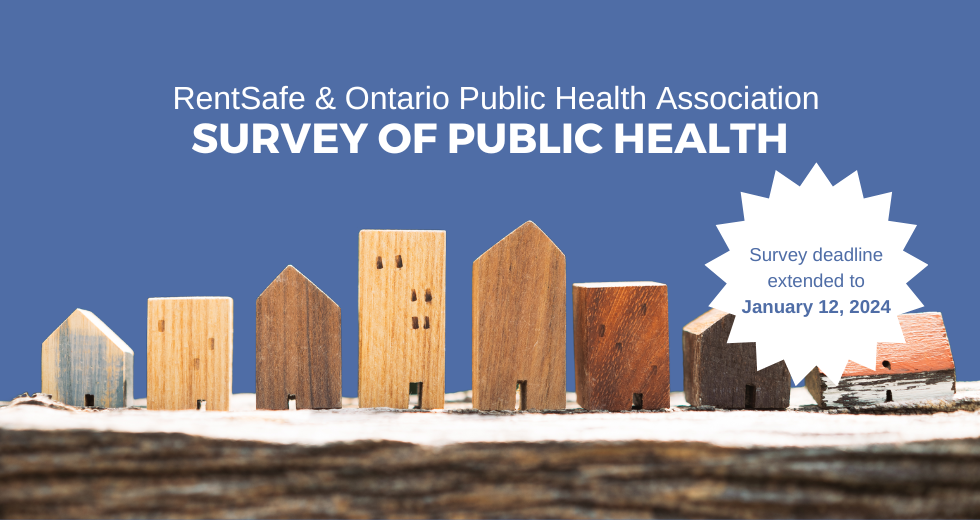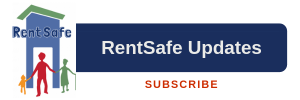Invitation to participate in the survey of public health units on approaches to unhealthy housing conditions and health equity in Ontario
November 27, 2023
OPHA and RentSafe invite you to participate in a survey of public health professionals about addressing unhealthy rental housing conditions in Ontario. We are seeking at least 1 response from each Public Health Unit in Ontario. Responses from multiple practitioners and/or teams in each Health Unit are welcome.
The survey is open from November 27 to January 12, 2024 (extended timeline).

Background Information
Click an item below to expand its section.
The issue of housing and health equity in Ontario
Unfit conditions in housing, disproportionately experienced by people living on low income or in other marginalizing circumstances, negatively affect physical and mental health. Multiple chronic diseases and acute effects – including asthma, respiratory conditions, allergies, chemical sensitivities, as well as cardiovascular disease and its numerous risk factors – can be exacerbated or, in some cases caused, by poverty, stress, and living in unhealthy conditions (see RentSafe report on Housing-Related Health Risks). [1]
Over 1.4 million people in Ontario, or 10.1 percent of the population, live on low income, defined as a household income of less than $53,005 per year for a family of four. [2,3] Just over 15 percent (15.3%) of Ontarians are in core housing need, defined as households with housing that does not meet one or more of the standards for adequacy, suitability, and/or affordability, and that have to spend 30 percent or more of their income to access acceptable local housing. [4] Renters in Ontario are disproportionately affected by the housing crisis. Over one third (33.4%) of renters are in core housing need, and 40 percent of renters with children are in core housing need. [5] Ontario’s purpose-built rental housing supply is aging: 85% was built before 1980; this housing is more affordable than rental housing built after 2000. [6] More than half of Ontario’s renters (53.6%) live in a unit below one or more housing standards. [7]
- Schoen, Deborah . (2015). RentSafe Background Paper on Housing-Related Health Risks. https://rentsafecanada.files.wordpress.com/2018/10/rentsafebackgrounder_housingrelatedhealthrisks_final1540.pdf
- Statistics Canada (2022). Table 98-10-0103-01 Low-income status by age and gender: Canada, provinces and territories, census divisions and census subdivisions. https://doi.org/10.25318/9810010301-eng
- Statistics Canada (2022). Table 2.4 Low-income measures thresholds (LIM-AT and LIM-BT) for private households of Canada, 2020. https://www12.statcan.gc.ca/census-recensement/2021/ref/dict/tab/index-eng.cfm?ID=t2_4
- Statistics Canada (2017). Core housing need, 2016 Census. https://www12.statcan.gc.ca/census-recensement/2016/dp-pd/chn-biml/index-eng.cfm
- Canada Mortgage and Housing Corporation (2016). Core Housing Need (2016) – Ontario. https://www03.cmhc-schl.gc.ca/hmip-pimh/en#Profile/35/2/Ontario
- Government of Ontario. (2019). Housing Needs in Ontario. Community housing renewal: Ontario’s action plan under the National Housing Strategy. https://www.ontario.ca/document/community-housing-renewal-ontarios-action-plan-under-national-housing-strategy/housing-needs-ontario#
- Canada Mortgage and Housing Corporation (2016). Core Housing Need (2016) – Ontario. https://www03.cmhc-schl.gc.ca/hmip-pimh/en#Profile/3
Survey Reference List
- RentSafe. (2018). Towards Healthy Homes for All: RentSafe Summary and Recommendations. https://rentsafecanada.files.wordpress.com/2018/10/rentsafe-summary-report_final.pdf
- Swope, C.B. & Hernández, D. (2019). Housing as a determinant of health equity: A conceptual model. Social Sciences & Medicine, 243, 112571. https://doi.org/10.1016/j.socscimed.2019.112571
- Government of Ontario. (2021). Ontario Public Health Standards: Requirements for Programs, Services and Accountability. https://www.health.gov.on.ca/en/pro/programs/publichealth/oph_standards/docs/protocols_guidelines/Ontario_Public_Health_Standards_2021.pdf
- Government of Ontario. (2019). Ontario Public Health Standards: Health Hazard Response Protocol https://www.health.gov.on.ca/en/pro/programs/publichealth/oph_standards/docs/protocols_guidelines/Health_Hazard_Response_Protocol_2019_en.pdf
- National Collaborating Centre for Determinants of Health. (2021). Let’s Talk: Community Engagement for Health Equity. Antigonish, NS: NCCDH, St. Francis Xavier University. https://nccdh.ca/images/uploads/comments/Lets-Talk-Community-Engagement-EN.pdf
- Phipps,E., Butt, T., Desjardins, N., Schonauer, M., Schlonies, R., Masuda, J.R. (2021). Lessons from a rural housing crisis: grounded insights for intersectoral action on health inequities, Social Science & Medicine, 270, 113416, https://doi.org/10.1016/j.socscimed.2020.113416
Additional Background Literature
- MacDermid, Lindsay. (2015). RentSafe Public Health Unit Survey: Summary Report
- National Collaborating Centre for Determinants of Health. (2018). Towards healthy homes for all: What the RentSafe findings mean for public health in Canada
- Swope C., Hernández D., Yoon L. (Mar 30, 2023). The four pillars of housing influencing health equity [blog]. National Collaborating Centre for Environmental Health.
- Cohen, B.E. and Marshall, S.G. (2017), Does public health advocacy seek to redress health inequities? A scoping review. Health Soc Care Community, 25: 309-328.
 RentSafe
RentSafe

